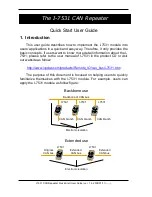
3-2
September 27, 2000
68P81093C75-O
Wireline Circuitry
The station wireline circuitry provides a wide variety of telephone
interfaces, including analog, ASTRO, ASTRO CAI, SECURENET,
Tone Remote Control, and DC Remote Control. Telephone line
connections are easily made to the wireline circuitry via connectors
on the top panel.
Switching Power
Supply
The station features a switching-type power supply, accepting a
wide range of AC inputs (85-265 VAC, 49-61 Hz). The power supply
generates 13.8 VDC for the station modules.
Standard Features
• Compact single case design
• Extensive Self-Test Diagnostics and Alarm Reporting
• FRU maintenance philosophy
• Easily programmed via Radio Service Software
• Local or Remote Software downloading to FLASH memory
• Upgrades performed by module replacement and/or software
upgrade
• Compatible (with appropriate options) with analog,
SECURENET, ASTRO, and ASTRO CAI digital signaling
• Versatile and reliable switching-type power supply
• Wide operating temperature range: -30˚ C to + 60˚C (-22˚ F to
+140˚ F)
Optional Hardware
Features
• Duplexer Option – allows a single antenna to serve for both
transmitter and receiver circuitry for repeater applications.
• Antenna Relay Option – allows a single antenna to be switched
between transmitter and receiver.
• ASTRO Modem – allows connection (for ASTRO digital
signaling) to a console through a Digital Interface Unit (DIU) in
an ASTRO system, also allows connection to another ASTRO
Modem for digital Cross-Patch.














































